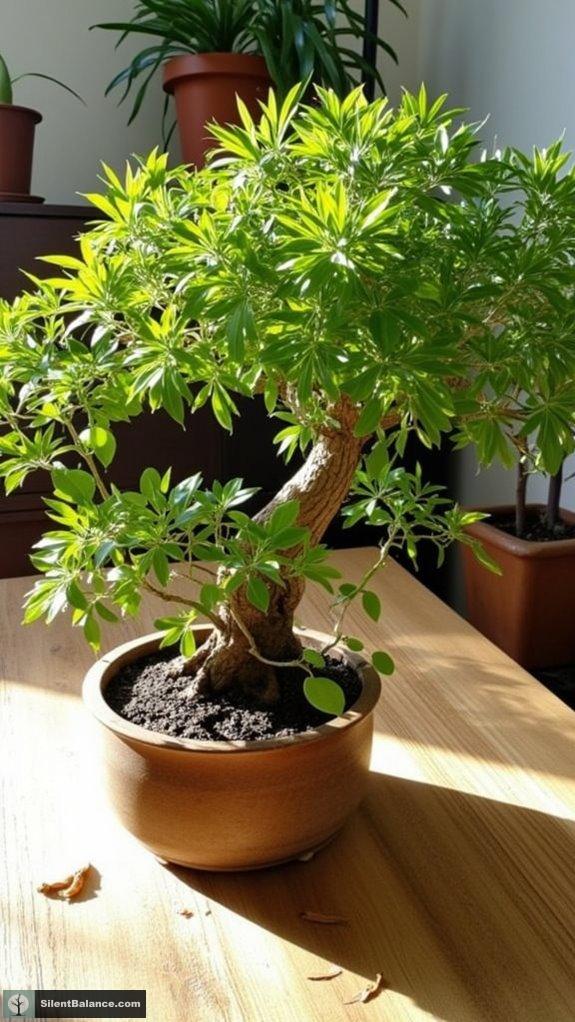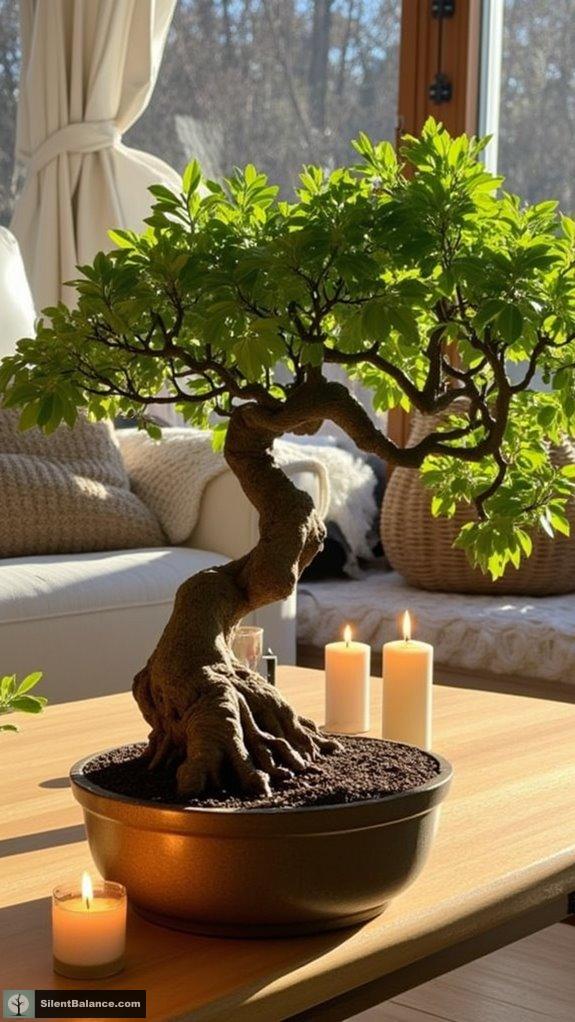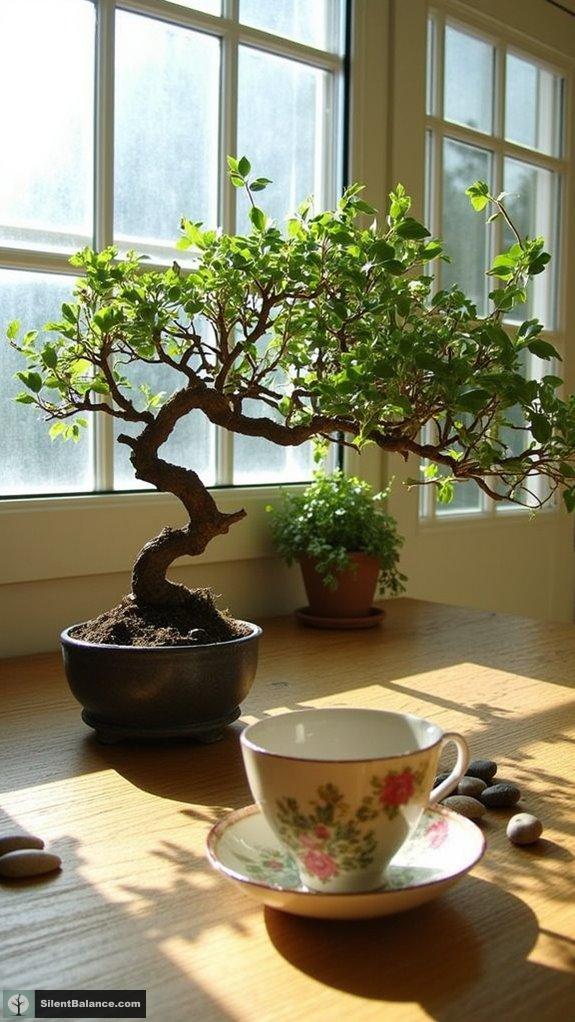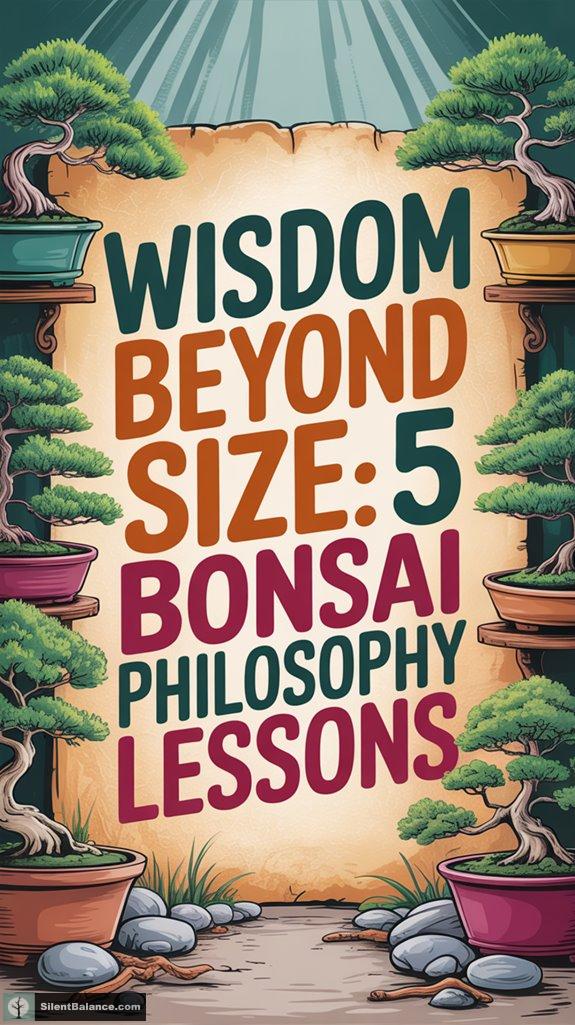Bonsai isn’t just about tiny trees; it’s a masterclass in life’s big lessons! Each twisty trunk teaches patience—like waiting for that perfect branch to beef up. Don’t forget to embrace imperfections, because wabi-sabi is where true beauty lies. It’s a dance of control versus nature, showing us balance. Plus, the mindfulness you develop while observing every leaf is a game-changer. And let’s not overlook how these miniature marvels capture life’s cycles. Stick around, and there’s even more wisdom waiting for you!
The Essence of Growth and Patience

Growth in bonsai is truly a labor of love.
You see, nurturing a bonsai isn’t just about snipping branches and adding fertilizer—it’s about patience and strategy. During the initial development phase, I focus on trunk thickening, fostering strong structural lines through careful energy management. Those heavy doses of nutrients? They’re essential for building that robust trunk. This phase emphasizes energy accumulation as the foundation for future growth. Understanding the importance of energy distribution helps to optimize the growth process and reinforce the structure of the bonsai.
Don’t rush it, though! Patience is key; the sacrifice branch technique reveals the truth—I’ll grow a branch just to remove it later, all in the name of a thicker trunk.
As my bonsai matures, I switch gears to controlled refinement, pruning and wiring to shape that masterpiece.
Isn’t it exhilarating to think of the final form, even when I know it might take years?
Embracing Imperfection and Wabi-Sabi

Creating a bonsai masterpiece isn’t just about chasing perfection; it’s about learning to embrace the quirks and imperfections that make each tree unique. The practice of bonsai embodies the principles of Buddhist symbolism in its careful attention to the natural form and character of each tree.
Wabi-sabi teaches us that asymmetry and weathered surfaces aren’t flaws, but rather, the marks of authenticity and character. Ever notice how an aged trunk tells a story of resilience? That’s the essence of *sabi*, where beauty emerges from those rough, rustic edges. When I see a bonsai that’s slightly crooked, I think, “Now that’s personality!”
This philosophy challenges our toxic pursuit of flawlessness and reminds us that in nature, and in ourselves, imperfection reigns. Bonsai, through its careful cultivation, reflects the beauty of nature in miniature form, encouraging us to appreciate our surroundings even in their imperfect states.
The Interplay of Control and Natural Change

While cultivating a bonsai is often seen as a dance between control and nature, it’s really more like a dynamic conversation.
I shape the tree’s form with pruning and wiring, but I also respect its instinct for survival.
Isn’t it intriguing how I must assume the role of caretaker, ensuring it thrives in its confined pot?
Each day, I’m reminded this isn’t just about domination; it’s a delicate balance.
I’m coaxing nature into submission while embracing its natural flow.
Bonsai’s evolution isn’t a fixed art piece; it’s ever-changing, much like our lives.
Engaging in this practice can lead to profound insights about meditation techniques, revealing how patience and mindfulness play essential roles in personal growth.
Mindfulness and the Art of Observation

Mindfulness in bonsai isn’t just a fancy term; it’s a simple yet profound practice that transforms observation into an art form.
When I immerse myself in the details of a bonsai—those complex leaves, gnarled trunks, and delicate branches—I feel a surge of power, an almost meditative state.
Are you ready to engage fully? Use all your senses; touch the bark, inhale the earthy scent, listen to the rustle of leaves.
Each minute change reveals life’s rhythms, teaching patience and respect for growth.
As I breathe deeply, I sync my energy with the tree, reducing mental clutter and enhancing clarity.
This dance of observation isn’t just nurturing the bonsai; it’s a journey of self-discovery and tranquility.
Are you in?
Symbolism of Life’s Cycles in Miniature Forms

Every bonsai you’ve ever admired tells a story—a narrative stitched together through the cycles of life, both in the tree and in us.
These miniature marvels embody the transitory nature of existence, showcasing life’s relentless arc of birth, growth, decline, and renewal.
Have you ever pondered the seasonal changes? Each budding leaf or drooping branch whispers lessons of resilience and regeneration.
It’s true: bonsai captures life’s entire timeline in its complex forms.
As you observe its gnarled branches and weathered bark, you can’t help but appreciate the beauty in every phase, including decay.
This isn’t just art; it’s a power play against the fear of impermanence.
Bonsai Tree Symbolism

When you think about bonsai tree symbolism, what comes to mind?
For me, it’s all about striking the perfect balance. Bonsai represents harmony between nature and our intent, like a dynamic dance of masculine and feminine energy.
Caring for these mini masterpieces can bring a rush of peace and inner tranquility, don’t you think?
Each twist of a branch or shape of a trunk is an opportunity to reflect on our relentless journey for growth and self-discipline.
Plus, let’s not forget their historical allure—these tiny wonders have commanded respect across cultures, linking us to traditions and artistic legacies.
Summary
In the world of bonsai, each tiny tree whispers timeless lessons about life’s grand complexities. So, whether you’re pinching back those shoots or marveling at their gnarled trunks, keep in mind that patience pays off. Just like Master Jiro says, “The perfect sushi takes time to prepare”—so too does our personal growth. Let these miniature wonders remind you that it’s not the size of the tree, but the depth of its roots that counts. So, are you ready to embrace your own bonsai journey?
References
- https://www.mistralbonsai.com/en/bonsai-origin-and-philosophy/
- https://www.biotagroup.org/bonsai-training-the-entrepreneur-mindset/
- https://wazakurajapan.com/blogs/news/introduction-to-japanese-bonsai-and-wabi-sabi
- https://www.youtube.com/watch?v=cC70eWbK2ig
- https://bigthink.com/thinking/bonsai-tree-care-secret-philosophy/
- https://www.natesnursery.com/fundamentals-of-bonsai-stages-of-bonsai/
- https://bonsaimirai.com/blog/pinching-vs-pruning
- https://www.youtube.com/watch?v=yipjOk3HsrI
- https://www.bonsaiable.com/blog/bonsai-tree-growth-stages
- https://www.youtube.com/watch?v=7YhvVDB_b_0
- Bonsai Placement Benefits for Room Harmony - November 8, 2025
- Why Use Air Layering to Propagate Bonsai Trees? - November 8, 2025
- 15 Stunning Acorn Wood Wall Art Ideas - November 8, 2025

